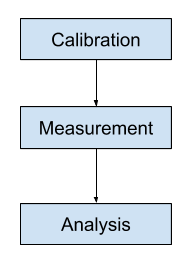
Sometimes, when we hear about a new bio-sensor, such as heart-rate-monitor or blood sugar measurement device, we might wonder why the good ones are so rare? There are several reasons, since we live in a hectic world. One reason, which might explain part of the question is that bio-measurement is not easy. It is actually quite hard – we know.
When we talk about bio-measurements or bio-monitoring, we are usually talking about measuring the composition of body fluids or gases, and making assumptions based on the measurement data.
That sounds quite easy, since we (as the human kind) have been able to send a man to the moon, and safely get him back too. Now we are talking about sending robots (simple but quite resourceful are there already) or man to the planet Mars. Why are we then claiming that bio-measurement is difficult or hard?
Measurement process
The measurements of the human body are not different than measurements from any physical object. It follows the procedure, which phases are shown in the Figure below:

We start with calibration phase, whose purpose is to make sure that measurements from John and Mary are comparable. They might have different colored pigments in the skin, or John has more hair in the area where the measurement is carried out. In the calibration phase the range of valid measurement values are determined. Most of crude calibration of measurement devices are made during manufacturing.
In the measurement phase, the data is measured. Depending of the phenomena, different methods can be used. Usually, the first categorization is done based on whether the method is destructive or non-destructive. If a blood sample is taken, the method can be destructive (the sample is destroyed during measurement), but if continuous measurement is required, non-destructive method is more favored.
The analysis phase concentrates in data analysis. We compare the measured data to model, which describes the phenomena we are looking into. There exist simple models and complex models, but when we are talking about bio-measurements, the models tend to be more in the complex end of the spectra. The analysis in the measurement device is usually done by a algorithm – a piece of dedicated software. The more complex the model is, usually the algorithm is also more complex.
There exists strong chain of dependency; if the calibration phase goes wrong, the measurements will fail. And in the analysis phase we are not able to find something which is not measured.
Problem of scale
As we know, the normal amount of fasting glucose (blood sugar) ranges from 0.7 to 1.0 grams per liter of blood. This sounds a lot. But we must remember that we do not give a liter of blood to testing. The average blood sugar measurement devices take about 3.0 micro liters of blood for the test strip. This means that the device is capable of measuring, with accuracy, 2.4 nano grams of glucose from the sample, and the fancy thing is that also the deviation from that amount! Some devices can do the measurement from 0.3 micro liters of blood.
This is in the same level of difficulty, than determining the direction and speed of tennis ball, from a distance of 100 meters. It can be done, but it gets easier if we can alter the environment. With some bio-signals we can get better results, when we measure the absence of component compared to the result from measuring the actual component. Same applies to our tennis ball.
When we change the tennis ball to ping pong ball, or smaller object and get further away, we might even turn into using statistical analysis. This means that our models become more complex, and as that happens, the analysis is performed with more complex algorithms.
When we would like to measure the amount of vitamin B12 in the blood, we are talking about amounts of 0.3 micro gram per liter. This would analogue in our previous tennis ball example as measuring the movements of a human hair at the top of the tennis ball.
As a conclusion, it is easy to state, that measurable changes in the human body fluid or gas balance are quite small. Measurement of those can be done. Challenges arise when the devices need to be mobile and easy to carry with us. New technology is based on science, and science has daily advances. The things we yesterday thought were impossible are today easy.
If this raised any thoughts, please join us at Cambridge 25-26 September at IDTechEx Healthcare Sensor Innovations 2019 3-course Gala Dinner on 25th or at the exhibition on both days.
